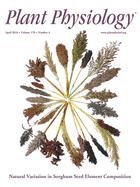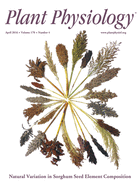
Cover image

On the Cover: On the Cover: Sorghum is a self-pollinated crop with cultivated varieties that span 5 races and over 25 species of wild relatives, providing tremendous genetic diversity for examining physiological and biochemical mechanisms at the population level. The continuous advancement of genomic resources in sorghum and related crops, such as rice and maize, allows for genome-scale analysis of complex traits and discovery of associated genetic and molecular elements. These resources were used to identify genetic targets for modification of seed element composition. Identification of genes and QTL that impact element traits in the grains of major cereals, including sorghum, is fundamental to developing breeding and selection strategies aimed at increasing seed nutritional quality. The cover shows a small cross section of the breadth of diversity found in sorghum panicles from more than 45,000 accessions maintained by the U.S. National Plant Germplasm System at Griffin, GA. Cover image credit: Nadia Shakoor, Donald Danforth Plant Science Center, Saint Louis, Missouri
Volume 170, Issue 4, April 2016
ON THE INSIDE
On the Inside
EDITORIAL
Does the Anonymous Voice Have a Place in Scholarly Publishing?
TOPICAL REVIEW
Nonphotochemical Chlorophyll Fluorescence Quenching: Mechanism and Effectiveness in Protecting Plants from Photodamage
Knowledge about the mechanism of non-photochemical chlorophyll fluorescence quenching adds to an understanding of its effectiveness at protecting plants from photodamage.
BREAKTHROUGH TECHNOLOGIES
Oligonucleotide-Mediated Genome Editing Provides Precision and Function to Engineered Nucleases and Antibiotics in Plants
Precise genome editing enables an herbicide tolerance trait in a commercially relevant crop by improving the outcome of DNA double strand break repair using single-stranded oligonucleotides.
RESEARCH REPORT
GIPS: A Software Guide to Sequencing-Based Direct Gene Cloning in Forward Genetics Studies
A software tool incorporating a range of experimental and data analysis choices in a sequencing-based forward genetics study aids in the design of an optimal procedure for gene identification.
Articles
BIOCHEMISTRY AND METABOLISM
A Picrinine N-Methyltransferase Belongs to a New Family of γ-Tocopherol-Like Methyltransferases Found in Medicinal Plants That Make Biologically Active Monoterpenoid Indole Alkaloids
Tocopherol-like methyltransferases in the Apocynaceae family of angiosperms are monoterpenoid indole alkaloid (MIA)-N-methyltransferases that contribute to chemical and biological diversity of the plants.
Modulation of Protein S-Nitrosylation by Isoprene Emission in Poplar
Isoprene emission modulates stress-induced NO production and S-nitrosylation pattern in poplar.
A Glycosyltransferase from Nicotiana alata Pollen Mediates Synthesis of a Linear (1,5)-α-L-Arabinan When Expressed in Arabidopsis
A type II transmembrane protein from tobacco pollen is associated with (1,5)-α-arabinan synthesis.
The Type II NADPH Dehydrogenase Facilitates Cyclic Electron Flow, Energy-Dependent Quenching, and Chlororespiratory Metabolism during Acclimation of Chlamydomonas reinhardtii to Nitrogen Deprivation
A NADPH dehydrogenase is critical for balancing electron flow between energy-dissipating and energy-generating pathways during the acclimation to photoautotrophic nitrogen deprivation.
Integration of Experiments across Diverse Environments Identifies the Genetic Determinants of Variation in Sorghum bicolor Seed Element Composition
Genome-wide association analysis identifies novel alleles controlling seed element accumulation.
Composition, Assembly, and Trafficking of a Wheat Xylan Synthase Complex
A xylan synthase engages an unusual regulatory mechanism linking ER complex assembly with forward trafficking.
CELL BIOLOGY
Suppression of Chloroplastic Alkenal/One Oxidoreductase Represses the Carbon Catabolic Pathway in Arabidopsis Leaves during Night
Suppressing a chloroplast oxidoreductase decreases carbon utilization during the night, and inhibits plant growth.
Posttranslational Control of ALA Synthesis Includes GluTR Degradation by Clp Protease and Stabilization by GluTR-Binding Protein
The protease post-translationally fine-tunes a key enzyme in the synthesis of 5-Aminolevulinic acid during photoperiodic growth.
Lipid Droplet-Associated Proteins (LDAPs) Are Required for the Dynamic Regulation of Neutral Lipid Compartmentation in Plant Cells
Lipid droplet-associated proteins play different roles in various physiological contexts and during plant stress responses.
ECOPHYSIOLOGY AND SUSTAINABILITY
The Contribution of Carbon and Water in Modulating Wood Formation in Black Spruce Saplings
During wood formation, water availability is the most important factor for cell production, while carbon is more important to sustain the differentiation of living cells.
Herb Hydraulics: Inter- and Intraspecific Variation in Three Ranunculus Species
Small herbaceous species are vulnerable to water stress but adjusted to their habitat conditions and internally coordinated to avoid hydraulic failure.
GENES, DEVELOPMENT AND EVOLUTION
Large-Scale Analyses of Angiosperm Nucleotide-Binding Site-Leucine-Rich Repeat Genes Reveal Three Anciently Diverged Classes with Distinct Evolutionary Patterns
Three ancient classes of genes encoding leucine-rich repeat proteins diverged into at least 23 lineages in the common ancestor of angiosperm, from which all current gene repertoires evolved through dynamic expansion.
WHITE PANICLE1, a Val-tRNA Synthetase Regulating Chloroplast Ribosome Biogenesis in Rice, Is Essential for Early Chloroplast Development
The White Panicle1 gene, encoding a Val-tRNA synthetase, plays an essential role in early chloroplast development.
Evolution of VRN2/Ghd7-Like Genes in Vernalization-Mediated Repression of Grass Flowering
Despite widespread vernalization responsiveness in the grass subfamily Pooideae, the flowering repressor VERNALIZATION2 evolved more recently in core members of this subfamily.
Auxin-Independent NAC Pathway Acts in Response to Explant-Specific Wounding and Promotes Root Tip Emergence during de Novo Root Organogenesis in Arabidopsis
Wounding induces expression of the NAC1 transcription factor that affects root tip emergence during de novo regeneration of adventitious root.
A Developmental Switch of Gene Expression in the Barley Seed Mediated by HvVP1 (Viviparous-1) and HvGAMYB Interactions
Two barley transcription factors interact to serve as a gene expression switch at key stages of seed development: maturation and germination.
Homodimerization of Ehd1 Is Required to Induce Flowering in Rice
Homodimerization of an inducer of florigen gene expression, Ehd1, promotes flowering, but can be interrupted by the response regulator OsRR1.
expVIP: a Customizable RNA-seq Data Analysis and Visualization Platform
expVIP is an adaptable platform to create an integrated gene expression interface for any species with a transcriptome assembly.
Genome-Wide Association Mapping and Genomic Prediction Elucidate the Genetic Architecture of Morphological Traits in Arabidopsis
Integration of genome wide association mapping and genomic prediction increases resolution of genetic architecture and uncovers missing heritability of quantitative traits in plants.
A Medicago truncatula Cystathionine-β-Synthase-like Domain-Containing Protein Is Required for Rhizobial Infection and Symbiotic Nitrogen Fixation
A Cystathionine-β-Synthase like protein, exclusively expressed during Medicago-Rhizobium symbiosis, is required for infection thread propagation and bacterial endocytosis.
A Predictive Coexpression Network Identifies Novel Genes Controlling the Seed-to-Seedling Phase Transition in Arabidopsis thaliana
A seed-to-seedling gene coexpression network reveals homeodomain leucine zipper I transcription factor AtHB13 as a novel key regulator affecting primary root length during late seedling establishment.
Transcriptome Profiling of Tiller Buds Provides New Insights into PhyB Regulation of Tillering and Indeterminate Growth in Sorghum
Buds of a phytochrome B mutant express high levels of the flowering regulators TFL1, TPPI, and gibberellic acid oxidase and become dormant, whereas wild-type buds with higher cytokinin/sugar induce a SWEET transporter, cell wall invertases, and grow into tillers.
Environmental Regulation of Heterosis in the Allopolyploid Arabidopsis suecica
An allopolyploid’s level of hybrid vigor may depend on environmental and ecological conditions.
MEMBRANES, TRANSPORT AND BIOENERGETICS
AtKC1 and CIPK23 Synergistically Modulate AKT1-Mediated Low-Potassium Stress Responses in Arabidopsis
Protein kinase CIPK23 and channel subunit AtKC1 are both crucial for the modulation of potassium channel AKT1 as well as for the response to low-potassium stress.
SIGNALING AND RESPONSE
Nitric Oxide, Ethylene, and Auxin Cross Talk Mediates Greening and Plastid Development in Deetiolating Tomato Seedlings
Light-evoked cotyledon greening and chloroplast differentiation in deetiolating tomato seedlings are orchestrated by regulatory feedback loops involving phytochromes, nitric oxide, auxins, and ethylene.
LLM-Domain Containing B-GATA Factors Control Different Aspects of Cytokinin-Regulated Development in Arabidopsis thaliana
Six Arabidopsis LLM-domain B-GATA transcription factors control greening, hypocotyl elongation, phyllotaxy, floral organ initiation, branching, flowering time and senescence.
PUB1 Interacts with the Receptor Kinase DMI2 and Negatively Regulates Rhizobial and Arbuscular Mycorrhizal Symbioses through Its Ubiquitination Activity in Medicago truncatula
The E3 ubiquitin ligase PUB1 is a common negative regulator for both rhizobial and arbuscular mycorrhizal symbioses and interacts with a key receptor kinase.
Spore Density Determines Infection Strategy by the Plant Pathogenic Fungus Plectosphaerella cucumerina
A plant-pathogenic fungus alters its infection strategy, depending on initial spore density on the leaf surface and intensity of the corresponding plant immune.
Salt Stress and Ethylene Antagonistically Regulate Nucleocytoplasmic Partitioning of COP1 to Control Seed Germination
Salt stress and ethylene antagonistically regulate the nucleocytoplasmic partitioning of the COP1 E3 ligase, thereby suppressing seed germination.
A Co-Opted Hormonal Cascade Activates Dormant Adventitious Root Primordia upon Flooding in Solanum dulcamara
Soil flooding reactivates dormant adventitious root primordia via ethylene-induced reduction in ABA level.
A Signaling Cascade from miR444 to RDR1 in Rice Antiviral RNA Silencing Pathway
Micro-RNA miR444 and its MADS-box targets directly alter RNA-dependent RNA polymerase transcription in antiviral defense.
SUMO Is a Critical Regulator of Salt Stress Responses in Rice
The OsOTS1 SUMO protease acts in the nucleus to promote root growth and confer salt tolerance.
The Thioredoxin GbNRX1 Plays a Crucial Role in Homeostasis of Apoplastic Reactive Oxygen Species in Response to Verticillium dahliae Infection in Cotton
The root apoplast secretome of Gossypium barbadense actively changes upon infection, and a thioredoxin plays an important role in apoplastic ROS balance.
Herbivore-Triggered Electrophysiological Reactions: Candidates for Systemic Signals in Higher Plants and the Challenge of Their Identification
Feeding caterpillars trigger various types of electrophysiological reactions with diverse voltage patterns that are specific for plant species.
The Mechanistic Underpinnings of an ago1-Mediated, Environmentally Dependent, and Stochastic Phenotype
Perturbation of AGO1, a key enzyme in microRNA metabolism, sensitizes seedlings to stochastic instances of cell death due to up-regulated jasmonate signaling.
Arabidopsis MYC Transcription Factors Are the Target of Hormonal Salicylic Acid/Jasmonic Acid Cross Talk in Response to Pieris brassicae Egg Extract
Repression of the jasmonic acid pathway by insect eggs is associated with degradation of transcription factors that control defense gene activation.
AtPDCD5 Plays a Role in Programmed Cell Death after UV-B Exposure in Arabidopsis
A programmed cell death protein, by its interaction with histone acetyltransferases, has an important role during DNA damage responses induced by UV-B radiation in Arabidopsis.
HsfA2 Controls the Activity of Developmentally and Stress-Regulated Heat Stress Protection Mechanisms in Tomato Male Reproductive Tissues
A heat stress transcription factor is involved in tomato pollen thermotolerance, contributing to stress responses as well as the abundance of chaperones in the priming program activated during microsporogenesis.
Two bHLH Transcription Factors, bHLH34 and bHLH104, Regulate Iron Homeostasis in Arabidopsis thaliana
Two transcription factors positively regulate Fe homeostasis by activating the transcription of the Ib subgroup bHLH genes.
SYSTEMS AND SYNTHETIC BIOLOGY
Arabidopsis Small Rubber Particle Protein Homolog SRPs Play Dual Roles as Positive Factors for Tissue Growth and Development and in Drought Stress Responses
A small rubber particle protein homolog plays dual roles as positive factors in post-germination growth and the drought stress tolerance response
HvPap-1 C1A Protease and HvCPI-2 Cystatin Contribute to Barley Grain Filling and Germination
Over-expressing or silencing proteases or their inhibitors alter the metabolite composition of the grain and modify the germination process in barley


